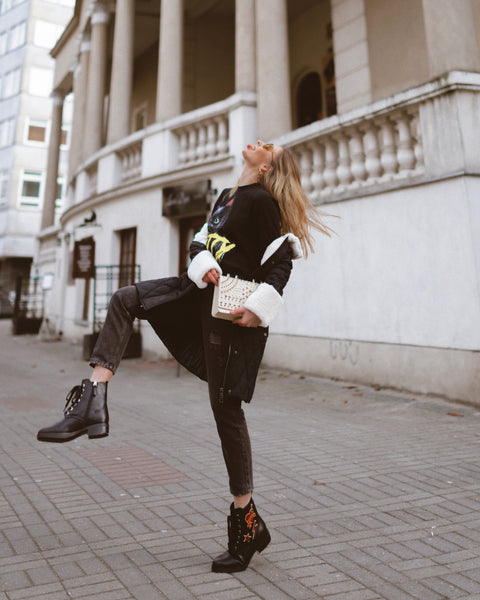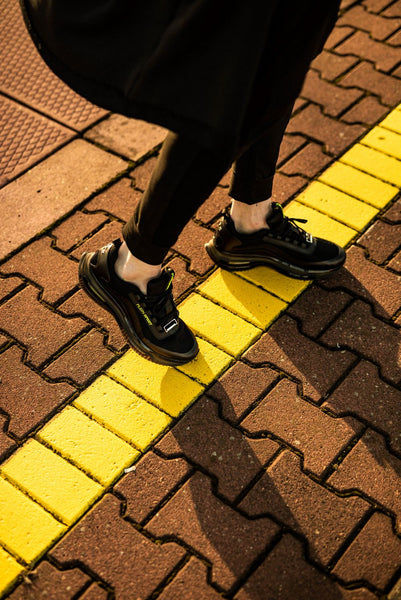How to protect your shoes from getting wet? Expert advice
Introduction:
Have you ever come home with wet feet after a walk in the rain? Soaking shoes are not only uncomfortable, but they can also shorten the life of your favorite pairs.
In this article, we will share proven methods that will help protect your shoes from getting wet. We will learn the secrets of choosing resistant materials and learn how proper care affects the durability of footwear.
Whether it's high heels , ankle boots, sports sneakers or elegant leather shoes , you will find practical tips on how to care for each type of footwear.
You will learn how to properly prepare and protect your favorite pairs so that they serve you for a long time, maintaining their functionality and aesthetic appearance.

Choose the right material:
The first and fundamental step in preventing your shoes from getting wet is consciously choosing shoes made of waterproof materials. Perfect candidates here are impregnated leather, rubber and various types of synthetics.
These materials have a natural water resistance, which makes them not only more practical on rainy days, but also easier to maintain on a daily basis.
Impregnated leather is a great choice for those who value elegance and style. It is natural leather that has been specially treated, thanks to which it copes better with moisture.
Remember, however, that even impregnated leather requires regular care to maintain its waterproof properties.
Rubber, known primarily from the production of Wellington boots, is irreplaceable in very wet and muddy conditions.
Rubber shoes are perfect for walking in heavy rain or gardening. They are easy to clean and perfectly protect your feet from getting wet.
Synthetics such as nylon or polyester are often used in the production of sports and trekking footwear.
Thanks to their lightness and durability, synthetic shoes are suitable for active people who need reliable protection in various weather conditions.
It is worth noting that regardless of the material chosen, regular impregnation and proper care are crucial to keep the shoes in good condition and extend their life.
Regular impregnation:
Waterproofing is an indispensable element of footwear protection, regardless of whether they are elegant leather shoes, comfortable shoes or even summer flip-flops.
Waterproofing agents work by creating an invisible layer on the surface of the shoe that effectively reflects water. It is this barrier that keeps the shoes dry even on rainy days.
It is recommended to use impregnations regularly, at least once a season, to maintain high water resistance. If your shoes are used frequently, especially in difficult weather conditions, even more frequent waterproofing may be necessary.
This is especially important in the case of shoes made of natural leather, which are susceptible to damage caused by moisture.
Some footwear models, such as trekking or sports shoes, may require special types of impregnations tailored to their material and purpose.
Leather shoes, on the other hand, will be best protected by impregnations designed specifically for natural leather.
It is important to always follow the recommendations of the waterproofing and footwear manufacturer to ensure the best protection and not to damage the material.
Remember that regular impregnation not only protects your shoes against getting wet, but also helps maintain their original appearance and color for a longer time.

Use shoe polishes and creams:
Regular use of shoe polishes and creams is important not only to emphasize their aesthetic appearance, but also to increase their water resistance.
These products, available in various formulas, are invaluable in the care of various footwear models, from elegant shoes to light flip-flops.
Shoe creams and polishes work in several ways. First of all, they intensively moisturize natural leather, preventing it from drying out and cracking .
This is especially important for customers who value shoes made of high-quality natural leather. Cracks and damage in the leather not only spoil the appearance of the shoes, but also reduce their water resistance.
In addition to protecting the skin, regular use of polishes and creams creates an additional protective layer on the surface of the shoe.
This layer not only refreshes the color and adds shine, but also helps reflect water, which is crucial in keeping your shoes dry on wet days.
It is important to choose products appropriate to the type of material the shoes are made of.
There are specialized preparations available on the market for various types of leather and synthetic materials, so it is worth spending some time finding the right product that will provide the best protection and care.
Home method of impregnating shoes - simple and effective
Did you know that you can effectively protect your shoes against water using items you probably have at home? All you need is a clear candle and a hair dryer. How to do it?
Start by thoroughly cleaning your shoes. Make sure there are no stains, dirt or dust on their surface. Clean and dry shoes are the key to success.
Then, use a candle or a piece of wax to cover the outside of the shoes.
Do it carefully, paying particular attention to sensitive places, such as the area around the sole or laces. After applying the wax, the surface of the shoes will be covered with a whitish layer, but don't worry - this is temporary.
The key step is drying. Turn the hair dryer on high and direct the hot air perpendicularly onto the surface of the shoes. The high temperature will cause the wax to penetrate deep into the structure of the material and the white traces will quickly disappear.
After completing this process, the shoes will be covered with an invisible, hydrophobic layer that will effectively protect them against getting wet.
Thanks to this simple and economical method, you can enjoy dry feet even on rainy days, without spending a fortune on specialized waterproofing agents. Try it and see for yourself!

Avoid extreme conditions:
While using protective measures is crucial to keeping your shoes in good condition, it is equally important to consciously avoid extreme weather conditions.
Even the most advanced impregnations may not cope with excessive moisture brought by deep puddles or heavy rainfall.
When wearing different models of footwear, including shoes or women's shoes, remember that the choice should be adapted to the weather conditions. For example, on rainy days it is better to avoid wearing delicate fabrics and choose shoes made of more water-resistant materials.
It is always worth having at least one pair of shoes in your wardrobe adapted to more difficult conditions, so as not to risk damaging the more delicate ones.
Moreover, conscious selection and use of footwear depending on the weather will not only extend the life of your favorite pairs , but will also ensure comfort and safety while walking.
Therefore, it is worth having a variety of shoe models in your wardrobe that will be suitable for various occasions and weather conditions.
Alternative solutions:
Although professional impregnations are by far the most effective, there are also alternative, home methods of increasing the waterproofness of shoes, which may prove helpful when we do not have access to specialized products. One such solution is to use beeswax.
Beeswax, natural and safe for many materials, can be gently rubbed into the surface of the footwear and then heated with a hair dryer to penetrate deeper into the structure of the material. This creates an extra layer of protection that helps repel water.
Another option is to use a hair spray. While it may sound unconventional, hair spray can temporarily increase the waterproofness of your shoes by creating a thin, water-repellent layer.
However, please remember that these types of methods are only a temporary solution and may not be suitable for all types of materials, especially delicate leather.
It is also worth mentioning other home remedies, such as using linseed oil or silicone sprays available in household goods stores. These products, while not specifically designed for shoes, may increase their waterproofing to some extent.

